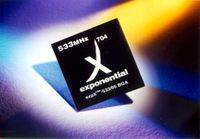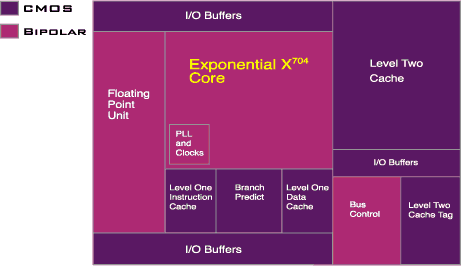| Line 17: | Line 17: | ||
| proc = 500 nm | | proc = 500 nm | ||
| tech = BiCMOS | | tech = BiCMOS | ||
| − | |||
| clock min = 400 MHz | | clock min = 400 MHz | ||
| clock max = 533 MHz | | clock max = 533 MHz | ||
| − | | package = CBGA- | + | | package = CBGA-356 |
| socket = | | socket = | ||
}} | }} | ||
| − | '''X704''' (stylized as '''X<sup>704</sup>''') was a family of high-performance [[PowerPC]] [[microprocessor]]s announced by [[Exponential Technology]] in [[1996]]. At the time, these chips ran over | + | '''X704''' (stylized as '''X<sup>704</sup>''') was a family of high-performance [[PowerPC]] [[microprocessor]]s announced by [[Exponential Technology]] in [[1996]]. At the time, these chips ran over three tims the clock rate as [[Motorola]]'s/[[IBM]]'s or [[Intel]]'s (albeit not as fast in direct performance). Exponential took over 18 months to get their final product to market by which time most of their competitive advantage was lost. Exponential's chips were also caught in the crossfire between [[Apple]] and [[Macintosh clone]] manufacturers, which ultimately sealed their fate. |
== Overview == | == Overview == | ||
| − | {{ | + | {{see also|Exponential Technology}} |
| + | Exponential took on a very ambitious challenge of designing a PowerPC [[microarchitecture]] from the ground up that could operate at extremely high clock frequency for the time - 533 MHz. Comparable chips at the time of Exponential founding were operating at only 50-75 MHz max. By [[1993]] the idea was backed by [[Apple]] and their CEO [[wikipedia:Michael Spindler|Michael Spindler]] which became the principal investor of the newly created company, [[exponential technology|Exponential]]. | ||
| + | |||
| + | In [[1994]] [[Apple]] and Exponential signed a juint development agreement and later that year they formed an agreement with [[Hitachi]] which agreed to manufacture their chip at their [[BiCMOS]] foundry. By [[1996]] with their chip just months away from [[engineering sample]], Apple's CEO, then [[wikipedia:Gil Amelio|Gil Amelio]] extended their agreement to gain exclusive rights to the chip for the first nine months of [[volume production]]. The deal included a $5 million prepayment - a payment Apple never delivered. | ||
| + | |||
| + | First samples of the X704 came back running at only 410 MHz, 75% of the expected speed. Exponential attributed the issue to a bug in their custom design tools. This pushed back the deliver date to March of [[1997]]. Even then, the chip would have been considerably faster than the fastest chips on the market at the time - Intel's {{intel|Pentium II|Klamath}} which ran as high as 233 MHz. | ||
| + | |||
| + | By February of [[1997]], the X704 was at the final stages. Around the same time, Exponential displayed an X704-based machine to journalists at the LA [[wikipedia:Dreamworks|Dreamworks Studios]], running complex 3D animations and wowing the audiences. About the same time, [[IBM]] announced a new chip: the {{ibm|Mach 5}}. While clocked at only 250 MHz, its considerably larger cache and wider datapath promised to match X704's performance. IBM chip was also to be manufactured on their new [[0.25 µm process]] (compared to X704's [[0.5 µm]]). | ||
== Architecture == | == Architecture == | ||
| + | {{main|exponential_technology/microarchitectures/x704|l1=X704 Microarchitecture}} | ||
{{empty section}} | {{empty section}} | ||
| Line 38: | Line 45: | ||
== Documents == | == Documents == | ||
| + | |||
| + | === Manuals === | ||
| + | * [[:File:X704 technical summary.pdf|X704 Technical Summary]], 1996 | ||
| + | |||
| + | === Papers === | ||
* C. A. Maier et al., "[http://ieeexplore.ieee.org/stamp/stamp.jsp?tp=&arnumber=641683&isnumber=13972 A 533-MHz BiCMOS superscalar RISC microprocessor]," in IEEE Journal of Solid-State Circuits, vol. 32, no. 11, pp. 1625-1634, Nov 1997. doi: 10.1109/4.641683 | * C. A. Maier et al., "[http://ieeexplore.ieee.org/stamp/stamp.jsp?tp=&arnumber=641683&isnumber=13972 A 533-MHz BiCMOS superscalar RISC microprocessor]," in IEEE Journal of Solid-State Circuits, vol. 32, no. 11, pp. 1625-1634, Nov 1997. doi: 10.1109/4.641683 | ||
Revision as of 13:18, 30 June 2016
| X704 | |

| |
| 533MHz X704 Promotional Picture | |
| Developer | Exponential Technology |
| Manufacturer | Hitachi |
| Type | Microprocessors |
| Introduction | October 21, 1996 (announced) |
| ISA | PowerPC |
| µarch | X704 |
| Word size | 32 bit 4 octets
8 nibbles |
| Process | 500 nm 0.5 μm
5.0e-4 mm |
| Technology | BiCMOS |
| Clock | 400 MHz-533 MHz |
| Package | CBGA-356 |
X704 (stylized as X704) was a family of high-performance PowerPC microprocessors announced by Exponential Technology in 1996. At the time, these chips ran over three tims the clock rate as Motorola's/IBM's or Intel's (albeit not as fast in direct performance). Exponential took over 18 months to get their final product to market by which time most of their competitive advantage was lost. Exponential's chips were also caught in the crossfire between Apple and Macintosh clone manufacturers, which ultimately sealed their fate.
Overview
- See also: Exponential Technology
Exponential took on a very ambitious challenge of designing a PowerPC microarchitecture from the ground up that could operate at extremely high clock frequency for the time - 533 MHz. Comparable chips at the time of Exponential founding were operating at only 50-75 MHz max. By 1993 the idea was backed by Apple and their CEO Michael Spindler which became the principal investor of the newly created company, Exponential.
In 1994 Apple and Exponential signed a juint development agreement and later that year they formed an agreement with Hitachi which agreed to manufacture their chip at their BiCMOS foundry. By 1996 with their chip just months away from engineering sample, Apple's CEO, then Gil Amelio extended their agreement to gain exclusive rights to the chip for the first nine months of volume production. The deal included a $5 million prepayment - a payment Apple never delivered.
First samples of the X704 came back running at only 410 MHz, 75% of the expected speed. Exponential attributed the issue to a bug in their custom design tools. This pushed back the deliver date to March of 1997. Even then, the chip would have been considerably faster than the fastest chips on the market at the time - Intel's Klamath which ran as high as 233 MHz.
By February of 1997, the X704 was at the final stages. Around the same time, Exponential displayed an X704-based machine to journalists at the LA Dreamworks Studios, running complex 3D animations and wowing the audiences. About the same time, IBM announced a new chip: the Mach 5. While clocked at only 250 MHz, its considerably larger cache and wider datapath promised to match X704's performance. IBM chip was also to be manufactured on their new 0.25 µm process (compared to X704's 0.5 µm).
Architecture
- Main article: X704 Microarchitecture
| This section is empty; you can help add the missing info by editing this page. |
Die Shot
Documents
Manuals
- X704 Technical Summary, 1996
Papers
- C. A. Maier et al., "A 533-MHz BiCMOS superscalar RISC microprocessor," in IEEE Journal of Solid-State Circuits, vol. 32, no. 11, pp. 1625-1634, Nov 1997. doi: 10.1109/4.641683
| designer | Exponential Technology + |
| first announced | October 21, 1996 + |
| full page name | exponential technology/x704 + |
| instance of | microprocessor family + |
| instruction set architecture | PowerPC + |
| main designer | Exponential Technology + |
| manufacturer | Hitachi + |
| microarchitecture | X704 + |
| name | X704 + |
| package | CBGA-359 + |
| process | 500 nm (0.5 μm, 5.0e-4 mm) + |
| technology | BiCMOS + and Bipolar + |
| word size | 32 bit (4 octets, 8 nibbles) + |

